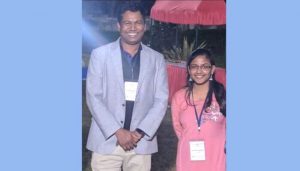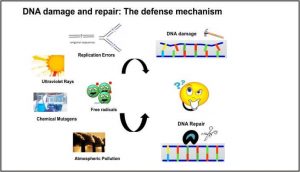Tanashree Jaganade, Ph.D student of Bioinformatics won the Best Poster Award as well as a Bursary Award as a fellowship at Australasia’s premier molecular modelling conference, organized by the Association of Molecular Modellers of Australasia (AMMA).
More details below.
All living systems have a unique mechanism by which damaged cells in the body are self-repaired. It is an attempt to maintain the integrity of the DNA in cells and the process is rather complex. The damage or lesions to the cells can occur due to various reasons such as environmental factors like UV radiation, pollution, and metabolic activities. One of the main reasons for ageing and cancer is such DNA damage accumulation.
DNA Repair Pathways
At IIITH, the bioinformatics research team led by Prof. Deva Priyakumar is currently researching on DNA repair pathways. “Cells use DNA repair enzymes to find these defects to restore the DNA which is vital for their integrity. In our study, titled Unravelling dynamics and energetic events involved in flipping process of Thymine Glycol lesion using computational approaches, we probed the mechanism by which one of the damages is repaired by an enzyme. Understanding this mechanism will help design new anti-cancer drugs,” says Prof. Priyakumar. One of the types of DNA repair mechanisms is the Base Excision Repair where the damaged base of the DNA is repaired by removing it and inserting the correcting base. PhD student under Prof. Priyakumar, Tanashree Jaganade explains the process simplistically by saying,”The aim of my study was to understand how the enzyme machinery can detect a lesion in the base thymine, excise it, and repair it. In other words, we analyzed how the original base thymine which was mutated to thymine glycol is recognised by the DNA glycosylase enzyme.”

Computational Approach
For excision repair to happen, large amounts of Mathematical and theoretical calculations are required. Experimentally mimicking biological processes is time-consuming and expensive too. With the aid of computational approaches, the research team was able to simulate various arrangements of the DNA’s helical structure in the presence of the glycosylase enzyme and in its absence too. That is, how the damaged base is flipped out and the correct base is added to the structure. The team’s observation was that excision repair was facilitated not only by the presence of glycosylase but also in the presence of water in the body, known as solvation. “We saw that water clusters very well around the mutated base and makes the excision repair process favourable,” says Tanashree.

Molecular Modelling Conference
The findings of this study were published in an attractive poster format and presented at the prestigious molecular modelling conference organized by the Association of Molecular Modellers of Australasia (AMMA) at Bintan island, Indonesia in December 2019. The themes of the conference included molecular dynamics simulations and quantum chemistry of biomolecules and materials, free-energy calculations and enhanced sampling approaches, computer-aided drug design, ML and AI in modelling and drug design, quantum computing and education in molecular modelling.

Best Poster Award
Tanashree won the Best Poster award in a competitive milieu that saw over 35 international participants showcasing their posters across diverse areas of molecular biology. Speaking of her win, Tanashree says, “It was a huge surprise for me too! I think it was the approach to solving the problem and the way I presented it that was novel for people”. For someone who has been a regular in the national conference circuit, Tanashree aced her first international conference too. Interacting and networking with people across different backgrounds, she formed lasting professional contacts at the venue. Crediting her advisor for giving her the opportunity to present at the international level, Tanashree says it definitely boosts one’s confidence. According to her, if both computational approaches and theory go hand in hand, they can work wonders in any research field. She is currently working on the manuscript of the paper to be submitted for publishing.


